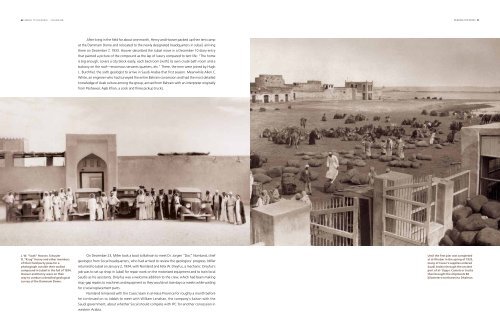Chapter 3 Reading the Rocks - Saudi Aramco
Chapter 3 Reading the Rocks - Saudi Aramco
Chapter 3 Reading the Rocks - Saudi Aramco
You also want an ePaper? Increase the reach of your titles
YUMPU automatically turns print PDFs into web optimized ePapers that Google loves.
64 energy to <strong>the</strong> world : Volume one<br />
reading <strong>the</strong> rocks 65<br />
After living in <strong>the</strong> field for about one month, Henry and Hoover packed up <strong>the</strong>ir tent camp<br />
at <strong>the</strong> Dammam Dome and relocated to <strong>the</strong> newly designated headquarters in Jubail, arriving<br />
<strong>the</strong>re on December 7, 1933. Hoover described <strong>the</strong> Jubail move in a December 10 diary entry<br />
that painted a picture of <strong>the</strong> compound as <strong>the</strong> lap of luxury compared to tent life: “The home<br />
is big enough, covers a city block easily, each bed room [with] its own crude bath room and a<br />
balcony on <strong>the</strong> roof—enormous servants quarters, etc.” There, <strong>the</strong> men were joined by Hugh<br />
L. Burchfiel, <strong>the</strong> sixth geologist to arrive in <strong>Saudi</strong> Arabia that first season. Meanwhile Allen C.<br />
White, an engineer who had surveyed <strong>the</strong> entire Bahrain concession and had <strong>the</strong> most detailed<br />
knowledge of Arab culture among <strong>the</strong> group, arrived from Bahrain with an interpreter originally<br />
from Peshawar, Ajab Khan, a cook and three pickup trucks.<br />
J. W. “Soak” Hoover, Schuyler<br />
B. “Krug” Henry and o<strong>the</strong>r members<br />
of <strong>the</strong>ir field party pose for a<br />
photograph outside <strong>the</strong>ir walled<br />
compound in Jubail in <strong>the</strong> fall of 1934.<br />
Hoover and Henry were on <strong>the</strong>ir<br />
way to conduct a detailed geological<br />
survey of <strong>the</strong> Dammam Dome.<br />
On December 23, Miller took a boat to Bahrain to meet Dr. Jorgen “Doc” Nomland, chief<br />
geologist from Socal headquarters, who had arrived to review <strong>the</strong> geologists’ progress. Miller<br />
returned to Jubail on January 2, 1934, with Nomland and Felix W. Dreyfus, a mechanic. Dreyfus’s<br />
job was to set up shop in Jubail for repair work on <strong>the</strong> motorized equipment and to train local<br />
<strong>Saudi</strong>s as his assistants. Dreyfus was a welcome addition to <strong>the</strong> crew, which had been making<br />
stop-gap repairs to machines and equipment so <strong>the</strong>y would not lose days or weeks while waiting<br />
for crucial replacement parts.<br />
Nomland remained with <strong>the</strong> Casoc team in al-Hasa Province for roughly a month before<br />
he continued on to Jiddah to meet with William Lenahan, <strong>the</strong> company’s liaison with <strong>the</strong><br />
<strong>Saudi</strong> government, about whe<strong>the</strong>r Socal should compete with IPC for ano<strong>the</strong>r concession in<br />
western Arabia.<br />
Until <strong>the</strong> first pier was completed<br />
at al-Khobar in <strong>the</strong> spring of 1935,<br />
many of Casoc’s supplies entered<br />
<strong>Saudi</strong> Arabia through <strong>the</strong> ancient<br />
port of al-‘Uqayr. Camels or trucks<br />
<strong>the</strong>n brought <strong>the</strong> shipments 80<br />
kilometers northwest to Dhahran.

















